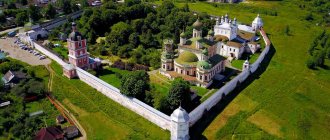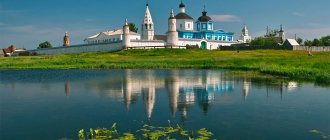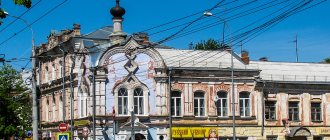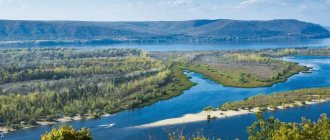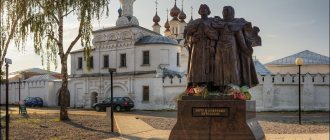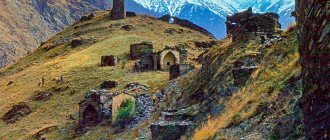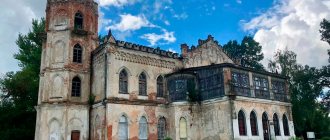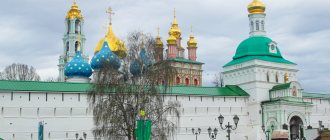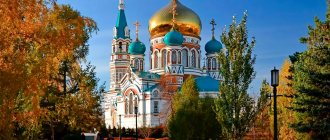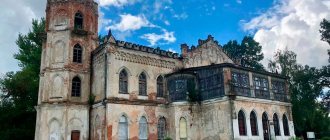Pereslavl-Zalessky is a rare example of a city that has survived from the 12th century. There are fourteen such cities in Russia (among them Moscow, Tver, Tula, Velikiye Luki, Volokolamsk). It was founded as a border protection settlement by Prince Yuri Dolgoruky and became the birthplace of the famous Alexander Nevsky.
It has preserved on its territory the remains of fortifications and earthworks of the 12th century, temples and monasteries founded in the 11th-17th centuries, unique places of worship of the ancient pagan Slavs. This makes it a place of pilgrimage for both Orthodox Christians and neo-pagans.
To make your trip more interesting, see what important places in the region you can visit on the way to and around Myshkin.
The city is part of the Golden Ring of Russia; about three hundred thousand people visit it every year, a considerable number of which are foreigners.
Other nearby cities of the Golden Ring, the visits of which can be conveniently planned with a trip to Pereslavl-Zalessky, are Sergiev Posad and Alexandrov. About all the cities of the ring, official and unofficial, in this list.
Lake Pleshcheyevo
Pereslavl-Zalessky stands on the shore of Lake Pleshcheyevo, which is almost perfectly round and looks like an overturned saucer from a height. The lake is thirty thousand years old, it is a trace left by a glacier traveling through ancient lands.
The age of the lake and its location allowed it to grow and preserve in its depths some endemic species, for example, the Pereslavl vendace and the relict marsh turtle.
The famous vendace is now listed in the Red Book, but, unfortunately, in shops in Pereslavl it can be found in smoked and salted form, albeit at an incredible price.
The size of the lake and the convenience of its sloping coastline in the 17th century prompted Peter the Great to think that it would become an excellent training ground for his Amusement Fleet.
At the moment, there are no shipyards or piers on the shores of the beautiful light lake. Many resorts and recreation centers offer water activities: kitesurfing in summer and snowkiting in winter.
The shores of the lake are sparsely built up, and you can simply walk along it, sit by the water, watching the waves splashing here since the times when there was not a trace of man on the Pereslavl land.
Where to stay
Since the geography of Pereslavl is quite extensive - the mileage along the shores of Lake Pleshcheevo is quite decent, we choose the location of residence depending on your capabilities and preferences, for a start it is convenient to evaluate it on the map:
If you want to live in the center, then I highly recommend taking a closer look at the guest house on the right embankment of the Trubezh River. It is both close to Lake Pleshcheevo and the Church of the Forty Martyrs and from the very center of the city. The reviews are very good, the rating is 9 points.
Another guest house is located here - with a rating of 9.7 points! Details here
Above, I already talked about the tourist complex in Veskovo, right on the shore of Lake Pleshcheevo, for travelers with a car - just the thing. I am duplicating the link .
Museum-estate "Boat of Peter the Great"
Address: Pereslavl district, Veskovo village Telephone: (48535) 6-21-16 Website: https://www.museumpereslavl.ru/ Opening hours: from May to September from 10.00. until 18.00, the ticket office is open until 17.30 from October to May from 10.00. until 17.00, the ticket office is open until 16.30. day off - Monday. Cost: students under 16 years old - 100 rubles, pensioners and students - 150 rubles, adults - 200 rubles.
This is the oldest Russian provincial museum. It was founded in the 19th century. The main exhibit of the museum is the boat "Fortune", the only surviving witness to the ceremonial salvo in honor of the birth of the Russian fleet in the 17th century.
The conditions and care with which the boat was kept suggest that it was built personally by Peter the Great, and its name says the same thing: the great tsar respected capricious fortune and believed in it.
The museum-estate now includes:
- White Palace;
- Gatehouse;
- Rotunda;
- Triumphal Gate;
- Monument to Peter the Great;
- Obelisk to Peter the Great;
- Botny house.
On the territory of the museum-estate there is an interesting themed restaurant with the same name as the museum. The restaurant's interior is designed in the style of the hold of an old ship.
Blue stone
Address: Kriushkino village How to get there: along Kooperativnaya street (Nikitskaya Sloboda) along the shore of the lake 5 km to the village.
The legendary stone, a stone whose history is associated with many mystical secrets, continues to amaze people even now. Most likely, it arrived on Pereslavl land with a glacier and since then lay peacefully in a ravine until the ninth century, when its unusual color (and the stone, when wet in the rain, turns blue) and huge size (the weight of the stone is about 12 tons) attracted attention of the pagans. The stone became the center of rites and rituals dedicated to the spirit living in it, and since then it has seemed to come to life.
At the beginning of the seventeenth century, the monks of the Borisoglebsky Nadozerny Monastery, concerned that the pagans continued to organize games and dances around the stone, buried it, but already in the eighteenth century the stone came out again due to soil erosion.
Then they decided to attach it to a holy cause and lay it in the foundation of the Spiritual Church under construction, but during winter transportation across Lake Pleshcheyevo, the heavy stone went under the ice and hid at a depth of about three meters, only to appear on the shore again seventy years later.
Now the stone lies in the same place where it was washed up then. People come to the spirit of the Blue Stone with gifts and offerings: kvass, bread, grain. It is believed that all wishes made at the stone come true. This attention does not benefit the stone: pieces break off from it, its surface is contaminated with soggy bread.
There is a silent, friendly feeling of support from it, but apparently the stone is tired: for unknown reasons that even geologists cannot explain, it sinks into the ground. Its height is now just above the knee, but some twelve years ago it was more than one and a half meters high.
Visit the Blue Stone before it is completely hidden from human eyes. An incredible power emanates from the stone, which is felt by anyone who approaches it with respect.
Pereslavl Dendrological Garden named after. S.F. Kharitonov
Address: st. Zhuravleva, 1 Phone: (48535) 2-31-32 Website: https://www.botik.ru/park/dendrosad/ Opening hours: daily, 10.00 - 20.00, sale of entrance tickets until 19.00 Cost: 100 rubles.
A national dendrological park that you can return to many times: its territory covers as much as 58 hectares. There is a certain integrity in its diversity, woven from plants from dozens of countries: the park harmoniously combines compositions of trees, herbs and flowers brought from:
- China;
- Japan;
- North America;
- Europe;
- Crimea;
- Caucasus;
- Siberia.
The park's forbs and forests envelop you in aromas and green noise in the summer, delight with bright patterns of flowering, and in the fall they show the fiery splendor of extinction.
The park is decorated with wooden sculptures in the Russian style of an ancient wooden toy.
Goritsky Monastery
Address: Museum Lane, 4 Phone: (48535) 3-81-00 Website: https://museumpereslavl.ru/ Opening hours: from May to September: Tue-Sun 10.00 – 18.00. From October to April 10.00 – 17.00. Sanitary day is the last Tuesday of the month. In winter, the entrance to the bell tower is closed. Cost: https://www.museumpereslavl.ru/ru/visitor/price/
Founded in the 14th century under Ivan Kalita and lost its monastic significance in the eighteenth century. In the same century, the monastery lost its archives in a fire, and because of this loss, little historical reliable information about it remains.
The reasons for the abolition of the monastery also remain unknown: the huge complex, majestic and functional, could have fulfilled its role as a monastery for monks for many centuries, but for some reason it came into the possession of the Pereslavl bishop, turning into his estate. Perhaps ordinary human greed played a role in this matter.
The monastery remained an estate for no more than forty years, and then it began to overgrow, decay, and collapse... At the beginning of the twentieth century, it was completely littered with garbage and presented a sad spectacle of complete decline.
In 1919, it was saved by inclusion in the Pereslavl Museum-Reserve. On the territory of the monastery you will see:
- Assumption Cathedral (18th century);
- Bell tower and Church of the Epiphany (18th century);
- All Saints Church (17th century);
- Refectory Chamber (17th century);
- Church of St. Nicholas the Wonderworker (17th century);
- Column of the Church of Gethsemane (18th century);
- Holy gates, fortress walls and towers (17-18 centuries)
What to see in Pereslavl-Zalessky in 1 day
The city, which recently celebrated its 850th anniversary, is notable for the beauty of its quiet streets with white-stone walls of monasteries and golden domes of ancient Russian churches, surprises with its natural beauty, and gives guests a feeling of peace and grace.
The main attractions of Pereslavl-Zalessky are concentrated in the historical part of the city.
Pereslavl Kremlin
Over the course of 8 centuries, the city was built and developed around the Kremlin, the main fortification built by Yuri Dolgoruky. The fortress was destroyed more than once by enemy raids and rebuilt until the 18th century. Later, the fortification walls were demolished as unnecessary. From the Kremlin complex of buildings, part of the buildings of the Novodevichy Sretensky Monastery and the Transfiguration Cathedral have been well preserved to this day. Nowadays, the historical religious buildings belong to the Pereslavl-Zalessky State Historical and Architectural Art Reserve.
Address: Red Square, 56.
Nearest transport stops: "Prosecutor's Office", "Post". Visiting hours: from 9 to 18 hours.
Get directions
Red Square
This place is a witness to the centuries-old history of Pereslavl-Zalessky. Since the 12th century, the square has been a gathering place for townspeople to attend a meeting at the call of a bell mounted on oak pillars. Along the perimeter of the square between the temples were located the princely chambers and the “courtyard of the Great Sovereign,” where Alexander Nevsky was born in May 1220. From Red Square, the 21-year-old commander went to the famous battle with the German knights in 1241.
Nowadays Red Square is part of a historical and architectural art reserve. It is a lawn with paths leading to historical sites. The site is surrounded by protective earthen ramparts. The length of the ramparts is 2.5 km, the height is about 10 m. Behind the Spaso-Priobrazhensky Church there is a staircase leading to the observation deck.
Address: Red Square, 56.
Nearest transport stops: "Prosecutor's Office", "Post". Visiting hours: free.
Get directions
Transfiguration Cathedral
While walking along Red Square, you should definitely visit the ancient Cathedral of the Transfiguration of the Savior. The structure was built in the 12th century during the reign of Yuri Dolgoruky. Alexander Nevsky was baptized in this temple. Currently, the cathedral does not function as intended, being a branch of the local history museum. Only organized tourists with guides by appointment are allowed inside the building, which was restored in 2015.
Address: Red Square, 1A.
Nearest transport stops: "Prosecutor's Office", "Post". Visiting hours: from 9 a.m. to 5 p.m.
Get directions
Monument to Alexander Nevsky
Opposite the Transfiguration Church there is a memorial to the famous native of the ancient city. The beautiful monument organically complements the architectural ensemble of Red Square. The monument was inaugurated in 1958. In the inspired appearance of the Russian prince, inquisitive tourists will recognize the features of the hero of the Soviet film “Alexander Nevsky”.
Address: Red Square, 56.
Nearest transport stops: "Prosecutor's Office", "Post". Visiting hours: free.
Get directions
Peter the Metropolitan Cathedral
The church is located in the historical center of the city. The temple is brick, decorated in white, built in an atypical tent-roofed architecture. According to legend, the church was built on the site of the massacre of Metropolitan Peter on the orders of Ivan the Terrible, who considered the church minister his spiritual mentor. The temple is in need of renovation work. Services have been suspended indefinitely.
Address: Red Square, 6.
Nearest transport stop: "Prosecutor's Office".
Get directions
Goritsky Monastery
The city's famous places are not limited to Red Square. Tourists interested in the history of Rus' and those who revere Orthodox culture have another place to visit in Pereslavl-Zalessky. These are numerous surviving monasteries and temples.
The first religious attraction where you can and should go is the Goritsky Monastery. This is a masterpiece of Russian architecture of the 14th century. During the Tatar raid, it was destroyed, but was revived through the efforts and efforts of Prince Dmitry Donskoy’s wife, Evdokia, who miraculously escaped during the raid. The city honors a tradition established in those distant times - a religious procession from the walls of the monastery along the river in boats.
The monastery ceased its activities as a monastery in the middle of the 18th century. Nowadays the religious building is part of the historical and architectural museum-reserve. Within its walls there is an exhibition of objects of secular and religious art collected from closed monasteries and manorial estates.
Address: Museum lane, 4.
Nearest transport stop: "Museum". Visiting hours: from 9 to 18 hours.
Get directions
Monument to Yuri Dolgoruky
Where else to go while on the territory of the former Goritsky Monastery? We recommend going to the bronze monument with the image of Yuri Dolgoruky. The monument on this site was opened in 1963 in honor of the 810th anniversary of the founding of the city by the prince. The Moscow prince is embodied in the form of a bust; it is a fragment of an equestrian composition installed in Moscow on Tverskaya Square.
Address: Museum lane, 4.
Nearest transport stops: museum. Visiting hours: free.
Get directions
St. Nicholas Convent
No less interesting places to visit are the monasteries operating today. The history of the St. Nicholas Convent dates back to the 14th century; it is closely connected with the name of St. Dmitry of Priluki, the founder of the monastery. It was repeatedly destroyed by enemies: Tatar raids during the yoke, in troubled times - Lithuanians and Poles. After the revolution, on the territory of the monastery nationalized by the Bolsheviks, part of the religious buildings was blown up and a farm was built.
In 1994, the ancient monastery was returned to the church. Over the course of several years, two nuns and believers breathed life into the abandoned monastery. A large-scale restoration was carried out, and the number of nuns increased. Nowadays, the white stone monastery with golden domes is a place often visited by tourists and pilgrims. The monastery houses a religious shrine - the ancient Korsun cross.
Address: Gagarina st., 43.
Nearest transport stop: Garment Factory. Visiting hours: from 7 to 20 hours.
Get directions
Holy Trinity Danilov Monastery
Be sure to visit the monastery in Pereslavl-Zalessky. This historical site is just over 500 years old. During the years of unrest, the monastery experienced plunder, but was quickly revived. During the period of atheism under Soviet rule, it suffered minor losses. After the object was returned to believers in the 90s. In the 20th century, restoration work began here. The careful work of historians and artists has made it possible to preserve frescoes dating back to the beginning of the 17th century to this day.
The well of St. Daniel with miraculous water, dug by him during his lifetime, has been preserved in the monastery. Nowadays a two-story tower rises above the well. On the territory of the monastery, stone tombstones dating from the 19th-20th centuries are available for inspection.
Address: Lugovaya st., 7.
Nearest transport stop: Podgornaya. Visiting hours: from 7 to 21 hours.
Get directions
Cathedral of the Vladimir Icon of the Mother of God
A small functioning temple, illuminated in 1749. The Cathedral of the Vladimir Icon of the Mother of God is a bright representative of provincial Russian baroque. The building is distinguished by color contrasts: red walls with white trim and green domes. Miraculously surviving during the Soviet years, the temple, in addition to services in one of the halls, presents exhibitions of archaeological finds, paintings and photographs. Why not a place worth visiting?
Address: Sovetskaya, 12.
The nearest transport stop is "Prosecutor's Office". Visiting hours: from 8 a.m. to 3 p.m. On evening services - until 21:00.
Get directions
Church of the Intercession of the Blessed Virgin Mary
A church with an amazing history, illuminated in 1789. All the restoration work carried out over 2 centuries made it possible to preserve the temple in the same form as it looked 230 years ago. During the Soviet years, the building was used for its intended purpose and was the only functioning church in the city. The church, built in the Baroque style, has preserved the 19th-century iconostasis, ancient icons and wall paintings. We venerate the image of the miraculous icon of the Mother of God Bogolyubskaya - the main attraction of the temple.
Address: Pleshcheevskaya st., 13A.
Nearest transport stop: Children's Clinic. Visiting hours: from 7 to 19 hours.
Get directions
Estate of the artist Kardovsky
Famous monuments of Russian architecture have been preserved in Pereslavl-Zalessky. Kardovsky's estate demonstrates typical for the Yaroslavl province of the 19th-20th centuries. residential buildings. The artist and teacher D. N. Kardovsky inherited this two-story house before the revolutionary events of 1917. Returning to his native nest in 1941, he lived here for the rest of his years. Later the house was transferred to the Art Academy.
The first floor is stone, and over the years it has half sunk into the ground. The second is wooden, its windows are decorated with carved frames. In the courtyard, centuries-old linden trees from the once luxurious garden have been preserved.
Address: Moskovskaya st., 30.
Nearest transport stop: Bus Station.
Get directions
Pereslavl Kremlin
Address: Central part of the city, st. Soviet. Opening hours: around the clock Cost: free.
The Pereslavl Kremlin is still surrounded by high embankments and small ponds - the remains of former ditches and defensive structures. In the 12th century it was surrounded by wooden walls, and inside them there were princely mansions, outbuildings and the stone Transfiguration Cathedral, which you will see there even now.
The Kremlin was plundered by the Horde successively in the 13th, 14th, 15th centuries, after which it was carefully erected and fortified again by the inhabitants of Pereslavl. In the 16th century Sretensky Novodevichy Convent appeared on its territory.
The Kremlin is small, you can walk around it in half an hour. At the moment, only a few buildings remain from it, including walls: this is the Cathedral of the Vladimir Icon of the Mother of God, the Church of Alexander Nevsky.
Sights of Pereslavl-Zalessky
Pereslavl-Zalessky can compete with any city in the number of architectural monuments. Here you definitely won’t get bored sitting in a hotel room all day. The city offers entertainment for tourists with different interests. Museums, parks, exhibitions, churches, monasteries - you can see all this in Pereslavl-Zalessky, immersing yourself in the atmosphere of this unusual city.
In this material we have prepared for you a list of attractions in Pereslavl-Zalessky. You will be able to select and include in your route places that might interest you. If you don’t have enough attractions in the city itself, you can drive around the outskirts of Pereslavl and visit the most interesting and unusual places.
- Pereslavl Kremlin, Transfiguration Cathedral, Ramparts
- Radio Museum, Blue Stone, Source of the Holy Great Martyr Barbara
- Museum of Old Sewing Machines, Goritsky Assumption Monastery, Museum “Horse in a Coat”
- Church of Metropolitan Peter, Alexandrova Gora, Nikitsky Monastery
- Pereslavl Railway Museum, Vladimir Nevsky Cathedral, Museum-Estate “Boat of Peter I”
- Temple of the Forty Martyrs of Sebaste, Smolensk-Kornilievskaya Church, St. Nicholas Monastery
- Iron Museum, Russian Park Complex, Trinity Danilov Monastery
- Simeonovskaya Church, Museum of Cunning and Ingenuity, Feodorovsky Monastery
- Lake Pleshcheyevo, Alexander Nevsky Museum, Dendrological Garden
- Museum of Gramophones and Records, Sretenskaya Church, "Berendey's House"
- Church of the Intercession, Museum of Teapots, Pereslavl Museum-Reserve, Exhibition Hall “House of Artist”
- Poklonnaya Gory, Bibirevo village, Nikitskaya Church in Elizarovo
- Ganshin Estate, Smolenskoye Estate, Trinity Church in Trinity Slobodka
At the end of the article we have placed a map of Pereslavl-Zalessky with the sights marked on it that we mentioned in the article. Using this map, it will be easier for you to navigate the area, and also, if you wish, you can develop your own travel route through Pereslavl sights.
Nikitsky Monastery
Address: st. Zaprudnaya, 20, Nikitskaya Sloboda Phone: (48535) 3-20-08, 3-17-65 Opening hours: daily 7.00 – 20.00 Cost: free
The first church appeared on the site of the future monastery in 1010. Since then, its history has developed as follows: in the 16th century, Saint Daniel lived and worked here. In the seventeenth, the monastery was taken and burned by the Lithuanians; in memory of this event, two Lithuanian cannons can now be seen on the territory of the monastery.
In the eighteenth century, the monastery lost its main shrines: the chains and stone cap of St. Nikita were taken to Moscow. In the twentieth century, under Soviet rule, the monastery was plundered and handed over to secular authorities. A women's correctional labor colony was set up there.
Reconstruction and restoration began only in the late nineties of the twentieth century. Despite the difficult history, various architectural monuments and Orthodox shrines were erected on the territory of the monastery at different times and can now be seen.
Sixteenth century buildings:
- Fortress walls and towers
- Nikitsky Cathedral
Seventeenth century:
- Church of the Annunciation and refectory
- Tent bell tower
Eighteenth and nineteenth centuries:
- Pillar of Saint Nikita
- Monastic residential building
- Gate bell tower
- Chernigov Chapel
Sorokosvyatsky Church
Address: st. Left Embankment, 165 Phone: (48535) 9-85-11 Opening hours: Saturday 7.00 – 20.00, Sunday and holidays 7.00 – 15.00 Cost: free
It is relatively young compared to the rest of the temples and churches of Pereslavl: it was founded in the 18th century. It attracts the attention of tourists going in search of true antiquities due to its difficult location for construction: the muddy shore of Lake Pleshcheevo. The church is reinforced with piles, rocky embankments and special bridges and thanks to them it has retained its appearance for two hundred and fifty years.
The five-domed church with a bell tower survived Soviet times by a miracle that is associated with its dedication. It is dedicated to forty Christian martyrs who were executed for refusing to join pagan games and idolatry.
Legend has it that it was the holy martyrs who protected the church from destruction and encroachment by Soviet power, just as they once protected their souls from the secular power of the Roman emperors.
The place is very beautiful: the view of the smooth lake and the silence surrounding the church, the invisible presence of its holy defenders leave an impression that is called “grace”.
Pereslavl-Zalessky
In the morning we went to get acquainted with the city. It turned out that there was nothing special to get acquainted with - the city center had not been preserved.
The Cathedral of the Transfiguration of the Savior has been preserved, next to which the central city square was once located. The cathedral is the oldest building in North-Eastern Rus' and is considered the first example of the Vladimir-Suzdal white stone architectural school.
Not far from the cathedral is the tented church of Peter the Metropolitan, built in the 16th century. This is a later Moscow architectural school.
All. There is nothing else to do in the city itself. We're driving around the area.
Streets of Pereslavl
Pereslavl is small, but there are a lot of temples and monasteries visible from different parts of the city, so even a short walk will be enriched by the views.
You will be delighted by Rybnaya Sloboda : most of the paintings and drawings on boxes that are offered in Pereslavl as souvenirs depict landscapes of Rybnaya Sloboda. It is called “Russian Venice,” which does not really fit with its real name.
The areas of ancient streets and houses in the spirit of Russian architecture on the shores of the lake are becoming smaller and smaller due to the construction of modern cottages, so it is better to visit the settlement before it turns into an area of typical cottage development.
In Sokolskaya Sloboda you will find another monastery built in the 16th century: Holy Trinity Danilovsky . The monastery was erected in honor of the birth of Ivan the Terrible, and this dedication seemed to leave an imprint on the appearance of the monastery: severity, some architectural heaviness are reminiscent of the character of the famous Russian Tsar.
Going to Red Square, take a walk along the ancient earthen rampart : from there you can see the lake and the heads of the monasteries on the other side melting in the fog.
How to get to Pereslavl-Zalessky?
1. By personal car along the Yaroslavl highway. Travel time – from 2 hours.
Judging by the maps, 158 km and 2 hours separate me from home to my destination (Convenient parking. Start of the route). In reality, we rarely got there in less than 3 hours. If you are unlucky, you can drive much longer: repair work is currently underway on the Yaroslavskoye Highway and it will not end until the end of 2022 (judging by the sensations), so during the “hot” time it becomes really hot there. The situation is especially difficult near Pushkino near Moscow.
2. By bus from the station to VDNH. Travel time – from 3 hours.
The cost of a ticket is about 450 rubles , depending greatly on the bus route. This route is in great demand and there may simply not be enough seats; buy tickets in advance online or at the bus station ticket office. And I remind you that tickets for intercity flights can only be purchased using a passport.
I indicated the travel route on the map, in the same place as the walking route.
On the streets of Pereslavl
